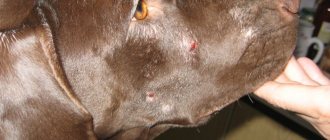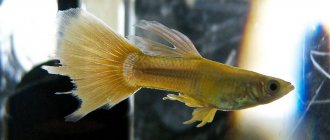Otodectosis develops when the outer ear of animals is affected by skin mites, another name is ear scabies. The disease does not belong to the category of complex, but dangerously severe consequences. In this review, I will tell you what otodectosis in dogs is, describe the symptoms, treatment, and medications for mild and advanced forms of the disease.
- Lotions.
What is an ear mite
What does a parasite look like? This is a very small insect, not reaching one millimeter, with a greyish-white translucent body, with a gnawing mouthpart. It gnaws through the skin and makes passages under it, laying eggs in them.
Ear mites under a microscope
The wounds become inflamed and fester. The larvae, feeding on the products of suppuration and lymphatic fluid, reach sexual maturity after 3-4 weeks, and then also lay eggs. In a short period of time, an ear mite can damage not only the skin of a dog’s ear, but also the eardrum, and further penetrate into the inner ear and brain.
The disease develops unnoticed - when the animal begins to show signs of the presence of a tick, then, as a rule, a significant part of the ear is affected. In addition, it was noted that the activity of the insect is subject to some cyclicity: a period of activity and bright symptoms is replaced by more or less calm intervals. This may be due to the cyclical development of the parasite. When pathology takes on threatening forms, there are no periods of rest.
Why is it dangerous?
The size of Otodectes cynotis is deceptive. the small parasite leads to death : it gnaws through the eardrum, through which pus enters the inner ear, and from there onto the membranes of the brain. But such a complication is rare and only in emaciated animals that are not treated.
Other possible consequences:
- the addition of a bacterial or fungal infection;
- purulent otitis;
- canal blockage;
- inflammation of the middle or inner ear;
- deafness;
- hematoma - if the pet damages blood vessels when scratching.
How can a dog become infected with ear mites?
Ear mites can be transmitted from one animal to another, regardless of what stage of development it is at. During itching, the dog intensively scratches its ears, contributing to the spread of the parasite throughout the entire surface of the body. That is, the tick and its transitional forms can be located anywhere the pet is.
A healthy animal can “catch” ear mites in the following ways:
- upon contact (even fleeting) with a carrier animal;
- through a grooming item used by an infected dog;
- from a person who had contact with an affected representative;
- through fleas (they can carry tick larvae);
- from the mother (in puppyhood).
Preventive measures
There is no guaranteed way to protect your dog from infection with ear mites. But you can minimize the risk. For this:
- examine the ears once every 2-3 days;
- note the consistency of the plaque;
- observe the behavior of the pet: they are wary when scratching, restlessness, shaking the head;
- Every 4 weeks the dog is treated for blood-sucking parasites, and once every 3 months for helminths;
- do not come into contact with stray dogs and pets whose health they are not sure of;
- Once every 1-2 months, the ears are lubricated with acaricidal preparations for prevention.
A reliable way to protect your dog from otodectosis is to buy an antiparasitic collar with acaricide. It secretes a toxin that is poisonous to ear mites and spreads over the dog’s skin. The accessory is valid for 3-6 months.
The best anti-parasitic collars are considered to be:
- “Preventik” – protects for up to 16 weeks, waterproof, contains fatty acids to improve the condition of the skin and coat, price – 650 rubles;
- "Preventeff" - works for 4 months, does not cause allergies, costs 450 rubles.
Dogs' ears are regularly infested with mites. Any owner will encounter them at least once a year. Therefore, every dog owner is required to know the treatment regimen and the names of acaricidal drugs.
Symptoms of ear mites
You can suspect ear mites in a dog if you find a dirty brown mass in the external auditory canal. It is formed from skin scales, particles of the outer integument of shed parasites, and the secretion of the ear glands. All this is mixed with purulent discharge from damaged areas of the epidermis and mite excrement, and leads to severe skin irritation and an inflammatory process.
Other ear mite symptoms:
- hyperemia of the skin of the ear canal;
- severe itching;
- swelling of the ear folds.
The dog is nervous, shakes its head, and often itches. When scratching or shaking the ears, particles of accumulated mass may fly out of the external auditory canal.
Routes of infection
The main source of scabies in dogs is communication with infected relatives. Pets with reduced immunity and chronic skin pathologies are at increased risk.
The disease is officially called “otodectosis of fur-bearing animals” - that is, theoretically, a dog can become infected from a cat, ferret, fox - any fur-bearing animal. The tick can be transmitted through care items (combs, collars), toys, beds. The owner's hands can also become a source of danger for the dog. Fleas can also carry tick larvae. In puppyhood, infection from the mother is possible.
Outside the animal's ear, the tick lives for a maximum of 24 days. Optimal conditions: temperature 3-7˚С, optimal humidity 85-93%. That is, in the summer and autumn, a dog may well become infected with a tick on the street, even without communicating with other animals.
In winter, the probability is significantly reduced: the tick dies at a temperature of -5 within 5 days.
The common myth that a person can become infected with ear mites from a cat or dog is only partially true. Hypothetically, when you clean the ears of a sick pet, a tick could get on your skin and even try to parasitize. However, humans do not have a suitable body temperature for the development of eggs and the reproduction of adult mites.
If the parasites manage to spread to a person, and this is possible when the immune system is stimulated and the body temperature is elevated, a local reaction occurs. The area of skin affected by mites turns red, begins to itch and swells.
Antihistamines can be used to relieve itching. Even without specific treatment, all symptoms will subside within a few weeks. If you find red spots on your skin and feel constant itching, you can use antiparasitic ointments.
What animals are at risk?
It has been established that ear mites most often “attack” young dogs less than six months old. The disease is characterized by a severe course and the development of complications.
Four-legged friends with long ears have an increased susceptibility to the parasite. Among them: dachshunds, spaniels, yorkies. Dogs of hunting breeds are a special risk group - they can become infected with ticks not only from other relatives, but also from wild animals.
Diagnostics
Diagnosing ear mites in dogs is not difficult: during the examination, the veterinarian will take material from the ear and look at it under a microscope. In the chronic form, bacterial seeding of the contents of the ear canal may be required to determine the sensitivity of the insect to drugs and to select the optimal drug. In advanced cases, a specialist may prescribe an X-ray examination or computed tomography to identify the condition of the inner ear and membranes of the brain. Additional diagnostic procedures include: bacterial analysis, scrapings, and allergy tests.
Medications
Medicines designed to combat ear mites come in different forms: drops, ointments, gels and aerosols. They are used in accordance with the instructions or recommendations of a veterinarian.
Amit Forte
Broad-spectrum acaricide for dogs and cats. It is a colorless or yellowish liquid, which is available in bottles or dropper pipettes.
The basis of the drug is fipronil, a toxic component that is active against both adult parasites and their larvae. When applying the composition, the ingredient accumulates in the sebaceous glands of the animal, as well as in the hair follicles and epidermis, affecting ticks for a long time. Antihistamine, anti-inflammatory and local anesthetic effects are provided by diphenhydramine; the development of full-fledged nymphs and pupae is prevented by diflubenzuron.
Amit is applied to the affected pre-cleaned areas at the rate of 0.5 ml per 1 kg of pet’s weight. The composition is distributed in an even layer, taking into account the coverage of healthy skin (up to 1 cm). Treatment is done 2 to 5 times with a break of 5-7 days.
Important!
The use of the drug is not recommended for puppies and kittens under 2 months, lactating and pregnant females, as well as weakened or sick animals with infectious diseases.
The cost of an Amit Forte dropper bottle (20 ml) is about 250 rubles.
Dekta
Ear drops for otodectosis
Drops for dogs against ear mites for external use based on amitraz, chloramphenicol and chloramphenicol. The combined drug has a detrimental effect on various types of ticks, including representatives of Otodectes cynotis. Available in the form of a homogeneous oily liquid of a yellow-brown hue.
To remove ear mites, drop 3 to 5 drops into each dog’s ear, distributing the oily composition with massaging movements. The duration of treatment is 2-3 procedures with an interval of 3-5 days. If necessary, the course of treatment is repeated until the pet is completely clinically cured, which is confirmed by two negative results of acarological studies.
Taking the drug is contraindicated in females during lactation and pregnancy, pets under one month old, as well as weakened animals. A bottle of Dekta (10 ml) costs about 130 rubles.
Review
Dekta is a unique remedy. The vet prescribed the drops to my dog when he diagnosed ear mites. We performed 2 procedures, and all symptoms of infection disappeared. I recommend it. Relatively inexpensive and very effective remedy.
Natalya, Tula
Leopard
Drops for the treatment of ear mites in dogs. They have acaricidal, bactericidal and anti-inflammatory effects. The active ingredient is diazinon. The composition is applied 3-5 drops into each ear opening. Treatment is carried out twice with a five-day interval. If necessary, treatment is repeated.
Important!
The drug is contraindicated in cases of damage to the eardrum, as well as in animals with hypersensitivity to the components of the drug.
Bars ear drops (20 ml) cost around 130 rubles.
Review
Bars drops have helped my pet out more than once: they treated otitis media and got rid of ear mites. A very effective remedy. I recommend.
Polina, Krasnoyarsk
Acaromectin
Remedy for ear mites in dogs in the form of a spray. The composition, the active ingredient of which is ivermectin, blocks the passage of nerve impulses, which causes paralysis and subsequently the death of parasites. It is enough to spray the inner surface of the ear twice with an interval of 8-10 days.
Despite the fact that the composition has a low concentration of toxicity, it is not recommended for use by weakened, emaciated animals or those suffering from infectious diseases. The price of a 25 ml bottle is about 135 rubles.
Otodectin
Ear drops for otodectosis
Medicine for ear mites in dogs, presented in the form of an injection solution. An antiparasitic drug based on ivermectin has a wide spectrum of action and is intended for the treatment of carnivores. It is also used in the treatment of ear mites in dogs.
The injection solution is injected subcutaneously into the forearm or at the back of the shoulder joint at the rate of 0.2 ml per 1 kg of body weight. The drug is contraindicated in weakened and emaciated animals, puppies under two months of age.
Important!
Due to the increased sensitivity of the breed to avermectin compounds, when using the injection solution, the following breeds of dogs should be careful: collie, bobtail, sheltie, boxer.
The cost of a bottle of Otodectin (5 ml) is in the range of 60-80 rubles.
Review
My dog also had to deal with ear mites last summer. Just two injections of Otodectin, and there were no more parasites. Fast, effective, and most importantly, the medicine did not cause any “side effects” for the dog. I recommend.
Roman, Arkhangelsk
Ordermil
If you find a tick on a dog’s ear, you can also use Oridermil, an ointment that has antimicrobial, antiparasitic, antifungal and anti-inflammatory properties. The active ingredients in it are: permitrin, nystatin, lidocaine, neomycin sulfate, triamcinolone acetonide.
If the disease is accompanied by a fungal or bacterial infection, the composition is applied once a day for a week, if necessary, the course of treatment is repeated after 7 days. At the initial stage of the disease, the drug is used twice with an interval of 5-7 days; if necessary, the course of treatment is repeated after 1-2 weeks.
Contraindications include a damaged eardrum, hypersensitivity to the components of the drug, pregnancy and lactation, and weight less than 1.5 kg.
Important!
When using the ointment, do not drink, eat or smoke. It is necessary to limit contact of the treated pet with small children and other animals.
Oridermil ointment in a tube (10 g) costs around 520-550 rubles.
Is it possible to identify ear mites yourself at home?
There are situations when it is not possible to conduct a microscopic examination of a dog in a clinic. Before treating your pet for otodectosis, you can independently identify the parasite at home. To do this you will need a cotton swab, a piece of dark paper and a magnifying glass. Taking a small amount of plaque from your pet’s external auditory canal with a stick, you need to apply it to paper. If the disease is present, under a magnifying glass you can see moving ticks of a light gray hue.
Important: at the initial stages of pathology development, the population may be small. Therefore, the likelihood that the collected material will contain insects is reduced.
Current tips and tricks
Try on the role of Doctor Aibolit: clean the dog’s ear and examine under a magnifying glass what you manage to pull out of the ear on a piece of black or white paper. A magnifying glass, of course, is not a microscope, but even its capabilities are enough to examine moving microorganisms of light gray color.
If you manage to determine their presence, then you will certainly know that your dog has ticks. If an examination under a magnifying glass does not show anything, this will mean either that the pet is healthy, or that the disease is in the very early stages of enemies - the minimum, and your pet just needs regular prevention of tick infestation - inspection and cleaning of the ears.
Watch your pet carefully. Here are some symptoms (besides furious ear scratching) that should raise your alarm:
- dark brown discharge from the ears,
- skin irritation in the temple area,
- the dog experiences itching in the neck area,
- The dog tilts its head to one side and tries to keep it that way.
If these are your dog’s problems, then you will need the help of a specialist.
Well, you can provide your pet with additional protection - bathe him using insecticidal shampoo. Also, make it a habit to clean your dog’s ears. Purchase a drug from a veterinary pharmacy that softens wax that accumulates in the ear, and use it regularly.
After cleaning your ear, examine the cotton swab: if it is dirty, carry out a similar procedure the next day, and then again and again, until the swab is clean. After this, you can reduce the number of cleanings to one per week.
How to prepare a dog's ear for treatment
Before instilling ear mite drops, you need to clear your pet's ears of any accumulated mass. If the dog resists (not all animals tolerate this procedure stoically, especially if they experience pain), it is better to carry out the procedure together. For small sizes, you can throw a blanket over it or wrap it in a towel. If the pet is large, you should use a muzzle.
During the cleaning process, you must adhere to the following recommendations.
- You need to use sticks, not cotton swabs or disks, as there is a risk of pushing the accumulated mass deeper into the ear canal.
- You should start cleaning from areas located close to the edges of the ear, gradually moving deeper.
- The movements of the wand should be outward.
- If the masses are dry, you can wet the cotton end with peroxide or chlorhexidine. You can't put them in your ear.
- It is advisable to use lotions specifically designed for this purpose to clean your ears.
- If your dog has long hair growing on his ears, it will need to be cut off during treatment.
Folk remedies
As practice shows, traditional medicine is not effective enough. Therefore, treatment based only on folk remedies will worsen the situation. It is not worth using such drugs without a parallel therapeutic course.
But as an auxiliary and preventive purpose, drugs have the opportunity to exist:
- One of the most common remedies is the use of camphor oil, baby oil or cream to remove dried crusts. It is convenient to apply using cotton pads.
- To disinfect the ears, you can use hydrogen peroxide. To carry out the procedure, you need to moisten a cotton swab in a 3% peroxide solution and carefully treat the surface.
- A well-known antiseptic, green tea will also help remove bacteria from the surface of the hearing aid, as well as prevent the development of tick-borne infections.
Prevention
It is impossible to completely prevent your pet from becoming infected with ear mites. However, with the help of preventive measures, you can reduce the likelihood of developing the disease. To do this you need:
- do not allow the dog to come into contact with unfamiliar relatives;
- periodically carefully examine the animal;
- If you find brown plaque in your four-legged friend’s ears, visit the clinic as soon as possible and undergo an examination;
- periodically carry out preventive cleaning with special preparations, which are selected together with a veterinarian, taking into account contraindications and other nuances.
The disease has a favorable prognosis if detected early and treated correctly. At the very beginning of the development of otodectosis, it happens that the ear mites disappear after one cleansing procedure and use of the drug. In advanced cases, you need to be patient, follow the rules of hygiene for your pet’s ears, adhere to the treatment regimen, and increase the dog’s immunity.
FAQ
Can a dog spread ear mites to other pets?
Yes. At risk are dogs, cats, ferrets, and raccoons. All animals in contact must undergo treatment.
Can a person get ear mites from a dog?
Yes, ticks can move onto the human body, but they only parasitize animals; they quickly die on humans. The risk of infection is minimal; there is no need to be afraid of contact with your pet due to the fact that the tick is transmitted to humans.
However, some people prone to allergic reactions may develop a condition called “false scabies.” The symptoms of this allergic reaction are similar to those of otodectosis. This condition does not require treatment - as soon as the dog is cured, the person will lose all symptoms.
Risk group: which dogs are most susceptible to otodectosis
Frankly, dogs become infected with ear mites much less often than cats. But there is a certain risk group in the case of these pets:
- Long-haired breeds.
- Dogs with long ears are very susceptible to tick infestation.
- In addition, animals with soft and folded skin (Shar Peis, for example) are in a similar situation.
But not always and not in all cases does breed play a significant role. The combination of the following factors is much more important:
- The nutrition and general health of the pet (however, this is true for thousands of other diseases). The closer the dog is to its normal physiological form, the less likely it is to develop a tick infestation. Accordingly, obese and weakened, emaciated animals are equally convenient “targets” for parasitic mites.
- The younger or older the animal, the higher the likelihood of disease. Age factors have a bad effect on the immune system of dogs, and therefore the latter get sick much more often and much more severely (of course, this applies not only to otodectosis, but also to many other pathologies).
- Of course, initially sick pets “catch” parasites much more easily.
- Nutrition plays an important role. The better the pet’s diet is selected and balanced, the less likely it is that it will get otodectosis.











